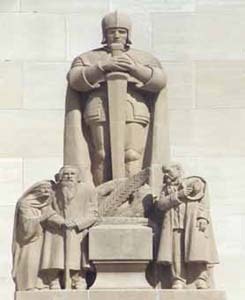
- Capital City:
- Baton Rouge
- Nickname:
- Pelican State
- Motto:
- Union, justice, and confidence
- Statehood:
- April 30, 1812 (18th)
- Origin of State's Name:
- Named in honor of France's King Louis XIV.
- Largest Cities:
- New Orleans, Baton Rouge, Shreveport, Lafayette, Kenner
- Border States:
- Arkansas, Mississippi, Texas
- Land Area:
- 43,566 sq. mi.; 33rd largest
- State Bird:
- Eastern Brown Pelican
- State Flower:
- Magnolia (magnolia)
- State Tree:
- Bald Cypress (taxodium distichum)
- State Song:
- Give Me Louisiana
Situated in the Deep South, Louisiana, the "Pelican State," has a colorful history and was named in honor of King Louis XIV. A strong French influence is still evident throughout the state--its capital city is named Baton Rouge, French for "red stick," because the French-Canadian explorer Pierre Le Moyne d'Iberville visited the area in 1699 and observed a red cypress post. Today the city of New Orleans is known for its Mardi Gras and jazz festivals.
Louisiana Folklife Festival
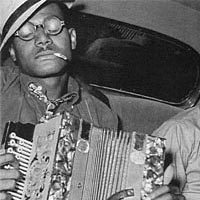
The Louisiana Folklife Festival grew out of the 1984 Louisiana World Exposition in New Orleans; the following year it became a stand-alone event which finally found a home in Monroe, Louisiana. The festival presents a wide variety of living traditions, from cooking to crafts, storytelling to music. Gathered for the event are African-American, Native American, Italian-American, Creole and Cajun cooks, each demonstrating traditional recipes and techniques on a live foodways stage. Craft tents feature over 30 traditional crafts from Choctaw baskets, to African-American walking sticks, from Mardi Gras masks to river fishermen's hoopnets and traps. Master storytellers share their talents on the Tales and Talk Stage. The Kid's Stage serves as a special area for performances by and for young people. But for most, the heart of the festival is music on three stages: everything from blues to bluegrass, from Celtic to zydeco. The 1999 festival offered a special focus on traditions from French-influenced Louisiana across all areas: music, narrative, crafts, and foodways.
Le Tour du Iberville
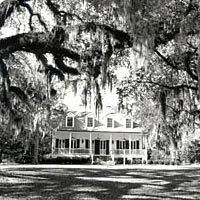
The rich cultural and geographic history of the Louisiana bayou country can be traced along the route taken by French-Canadian Pierre le Moyne, Sieur du Iberville, who in 1699 led an expedition to explore the Mississippi River and secure the claim of the Louisiana Territory as a French colony. Le Tour du Iberville was an official part of the Louisiana Tricentennial Celebration, known as "FrancoFete '99," a year-long commemoration of the 300th anniversary of the founding of Louisiana by du Iberville. His route extended from Mobile, Alabama, across the Mississippi Gulf coast, up the Mississippi River to the Houmas Native American Nation settlement at the confluence of the Red River, and across the north shore of Lakes Maurepas and Pontchartrain. On March 28, 1999 the Lacombe Heritage Center celebrated the 300th anniversary of the encampment of Iberville and four Canadians on Goose Point near the mouth of Bayou Lacombe.
The Lacombe Heritage Center is a nonprofit organization, which was founded in 1983 to coordinate all heritage activities of the region. It prepared this legacy documentation, which highlights the historic and cultural heritage of St. Tammany Parish, encompassing early southern Indians to 20th century Creoles, using du Iberville's route as a unifying theme. The center's goal is to initiate and coordinate a cooperative tourism program that would promote the region's legacy through a series of markers, monuments, museums, and activities.
The town of Lacombe is in St. Tammany Parish (county), a community of about 8,000 people, just north of New Orleans and covers about 900 miles. It is bordered on the east by the state of Mississippi, and on the south by Lake Pontchartrain. The area is known for its scenic beauty, comprising dens of pines and majestic moss-laden oaks. Lake Pontchartrain, which is surrounded by the city of New Orleans and northern parishes, was the unifying environmental, historical and cultural element in the development of colonial Louisiana along the northern Gulf of Mexico. All rivers and bayous on the north shore drain into the Lake Pontchartrain basin, which ties the estuarine system to the Mississippi River.
Early journals by explorers describe the immense terrain of this area, which was once covered with vast aquatic prairies, huge cypress swamps, and panoramas of tall pine forests. After defeat in the Civil War, and during Reconstruction, a coalition of civil and military occupying forces plundered the area, including carpetbagger corporations that clear cut huge 1,500-year-old cypresses in the Manchac Swamp and ancient long-needle yellow pine forests. The area was left with a legacy of erosion, subsistence, and drainage problems.
To protect and restore the natural resources, several parks, preserves, and wildlife refuges have been established in St. Tammany Parish during the 1900s. The Big Branch Marsh National Wildlife Refuge was created on October 24, 1994, along the north shore of Lake Pontchartrain. The refuge currently contains about 14,000 acres, of which 12,000 acres are marshlands and forested wetlands. These wetlands were threatened by urban expansion from the city of New Orleans. The Bogue Chitto National Wildlife Refuge, which includes 40,000 acres, much of it bottlomland hardwoods, is located in Washington and St. Tammany parishes and part of the state of Mississippi. Other areas are being reforested as a linear park a long an abandoned railroad line, called The Tammany Trace, it will have 2,100 oak trees, and also bluebird houses for the Mountain bluebird, which was nearly extinct. Other heritage projects include the Bayou Lacombe Rural Museum, which is housed in a restored 1913 school house, and plans for a Choctaw and Creole Heritage and Art Museum.
By 1999, St. Tammany was the fastest growing parish in Louisiana. Because much of the development has been unplanned, local citizens have organized "Visions 2025" to develop a master plan for the parish.
Documentation includes catalogs, booklets, brochures, festival information, newspaper and magazine articles, and books that document this legacy of St Tammany Parish. These include books on Bayou Lacombe, the Creoles of New Orleans, the cities of Slidell, founded in 1888 in St. Tammany Parish as a railroad town, and Mandeville, founded in 1840 on the lake, and a history of Madisonville.
Also included are a video and script of the play,Christmas in the Bayou, about missionary Adrien Rourquette who tended to the Choctaw Indians; a book of recipes that have been passed down through generations; a chronology on the Houma Indians; a 19th century diary by Francois Sidone Pichon; information and photographs of Veterans of Foreign Wars, Davis Memorial Post; a video of the 1995 Wooden Boat Festival in Madisonville; a collection of oral histories and stories; a map of the tour; reunion information about the LeFrere/Cousin family; the autobiography and family history of Morris R. Alfred; and articles and photos regarding the area's Scottish heritage, including the first Highland Games of Louisiana in 1999, held in Jackson, an area that would have been along du Iberville's route, and later settled by English, Scots, Irish and Welsh.
The LSU Rural Life Museum:Whispers of the Past
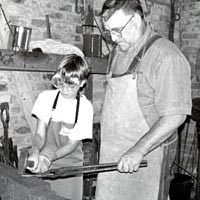
Located outside Baton Rouge on the 450-acre Burden Research Plantation, this museum preserves the pre-industrial heritage of Louisiana. 20 of its buildings are authentically furnished to illustrate major activities of a typical 19th century plantation, while seven other buildings represent various types of vernacular architecture of the region. The museum hosts interpretive programs throughout the year, including a week-long Rural Life Apprenticeship Program for children. This program features hands-on activities such as weaving, spinning, candle-making, blacksmithing, and open hearth cooking arts. The museum is documented in text, photos, brochures, news clippings, and a videotape in English, French, and German versions
Carville: The Gillis W. Long Hansen's Disease Center
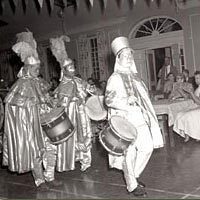
Documentation of the history of the last hospital in the industrialized world for the treatment of Hansen's Disease, better known as leprosy. More than a century after the first patients were brought by barge from New Orleans to an abandoned plantation for treatment in 1894, the facility's doors closed in June 1999.
Carville has always been a place of miracles. The first miracle was serving as a refuge for seven victims of leprosy who had been spirited from the New Orleans pest house. Over the years, the former Indian Camp sugar plantation evolved into a first-class hospital and research center, with the help of the patients themselves. After Carville was bought from the state of Louisiana, inmates became residents. In a crusading news magazine, which became famous worldwide, they sought to remove the stigma of the name leprosy replacing it with Hansen's Disease. The most phenomenal miracle to come out of the Gillis W. Long Hansen's Disease Center took place in the early 1940s when its medical director, together with the research labs, discovered that sulfones would cure leprosy -- for thousands of years deemed incurable. A Congressional bill, sponsored by Rep. Richard H. Baker in the late 1990s, gave long-term residents three choices: return to their own communities with a stipend; continue their care at another PHS hospital; or remain at Carville. Forty chose to remain, many of whom are helping to build a museum of the facility's history.
 Print
Print Email
Email







